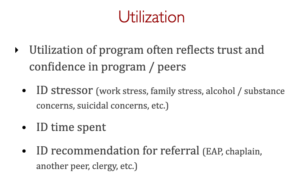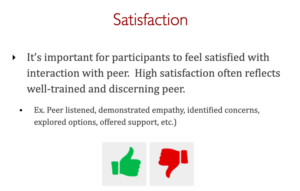
Please note: when we say “stats” we mean data (numbers). Peer programs must not violate the privacy and confidentiality of those seeking support. Names or any other identifiable information must never be collected, stored and shared with those outside the peer program.
There are 3 areas we recommend for stat collection: (1) utilization, (2) satisfaction and (3) improvement.
#1. Utilization simply demonstrates the numbers of people that are using (or utilizing) the program.
If numbers continually increase, leadership can infer program effectiveness, recognizing employees are “reaching out” and getting support.

#2. If utilization measures how many employees are using the program, then satisfaction measures how many of those people are satisfied – or pleased – with the services and support they received.
Capturing these numbers can be as simple as providing people with a survey, feedback form or questionnaire. The program coordinator may choose to ask questions like:
-
- During your time with the peer, did you feel heard, understood, acknowledged, etc.?
- Did you feel that your peer had a good understanding (grasp) of your concern?

#3. Reported improvement measures how much the individual reports hurting less and feeling better following their time with the peer.
The peer can capture this information by simply asking the individual the following:
“Before we leave (or hang up), I just want to ask you a quick question: before we started talking today, where would you say you were on the “stress-scale” (level to which you were feeling stressed) – 10 = high and 1 = low?” [note the number]
“Now that we’ve spent some time talking, where would you put yourself on the “stress-scale” – 10 = high and 1 = low? [note the number].
At that moment, the peer can acutally report if the individual’s stress increased, decreased or stayed the same as a result of peer engagement / intervention.

